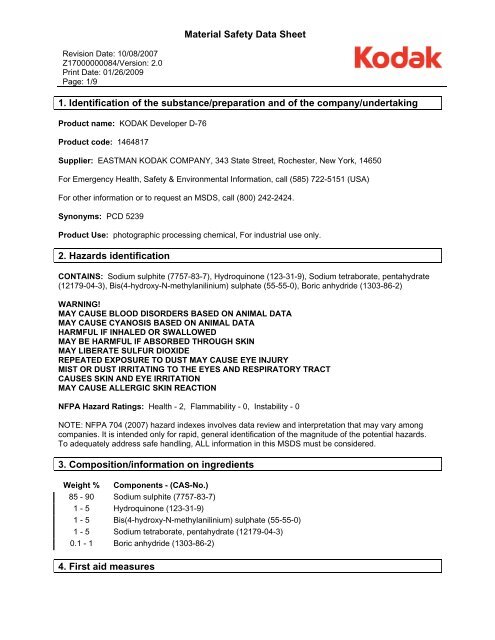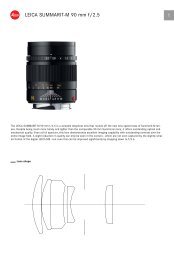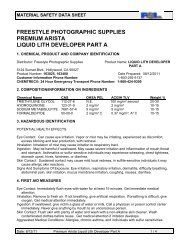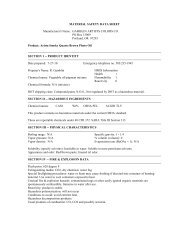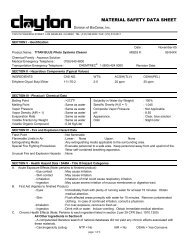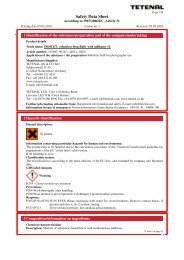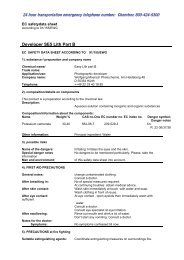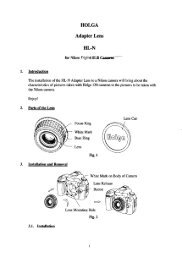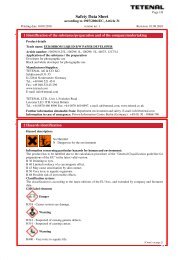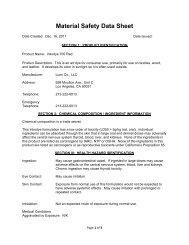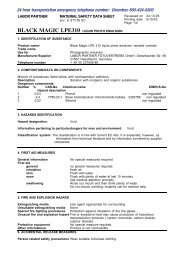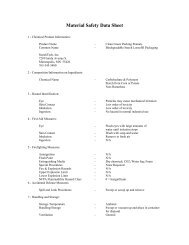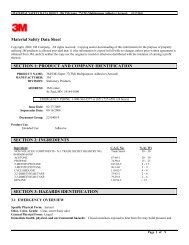KODAK Developer - Freestyle Photographic Supplies
KODAK Developer - Freestyle Photographic Supplies
KODAK Developer - Freestyle Photographic Supplies
Create successful ePaper yourself
Turn your PDF publications into a flip-book with our unique Google optimized e-Paper software.
Revision Date: 10/08/2007<br />
Z17000000084/Version: 2.0<br />
Print Date: 01/26/2009<br />
Page: 1/9<br />
Material Safety Data Sheet<br />
1. Identification of the substance/preparation and of the company/undertaking<br />
Product name: <strong>KODAK</strong> <strong>Developer</strong> D-76<br />
Product code: 1464817<br />
Supplier: EASTMAN <strong>KODAK</strong> COMPANY, 343 State Street, Rochester, New York, 14650<br />
For Emergency Health, Safety & Environmental Information, call (585) 722-5151 (USA)<br />
For other information or to request an MSDS, call (800) 242-2424.<br />
Synonyms: PCD 5239<br />
Product Use: photographic processing chemical, For industrial use only.<br />
2. Hazards identification<br />
CONTAINS: Sodium sulphite (7757-83-7), Hydroquinone (123-31-9), Sodium tetraborate, pentahydrate<br />
(12179-04-3), Bis(4-hydroxy-N-methylanilinium) sulphate (55-55-0), Boric anhydride (1303-86-2)<br />
WARNING!<br />
MAY CAUSE BLOOD DISORDERS BASED ON ANIMAL DATA<br />
MAY CAUSE CYANOSIS BASED ON ANIMAL DATA<br />
HARMFUL IF INHALED OR SWALLOWED<br />
MAY BE HARMFUL IF ABSORBED THROUGH SKIN<br />
MAY LIBERATE SULFUR DIOXIDE<br />
REPEATED EXPOSURE TO DUST MAY CAUSE EYE INJURY<br />
MIST OR DUST IRRITATING TO THE EYES AND RESPIRATORY TRACT<br />
CAUSES SKIN AND EYE IRRITATION<br />
MAY CAUSE ALLERGIC SKIN REACTION<br />
NFPA Hazard Ratings: Health - 2, Flammability - 0, Instability - 0<br />
NOTE: NFPA 704 (2007) hazard indexes involves data review and interpretation that may vary among<br />
companies. It is intended only for rapid, general identification of the magnitude of the potential hazards.<br />
To adequately address safe handling, ALL information in this MSDS must be considered.<br />
3. Composition/information on ingredients<br />
Weight % Components - (CAS-No.)<br />
85 - 90 Sodium sulphite (7757-83-7)<br />
1 - 5 Hydroquinone (123-31-9)<br />
1 - 5 Bis(4-hydroxy-N-methylanilinium) sulphate (55-55-0)<br />
1 - 5 Sodium tetraborate, pentahydrate (12179-04-3)<br />
0.1 - 1 Boric anhydride (1303-86-2)<br />
4. First aid measures
Revision Date: 10/08/2007<br />
Z17000000084/Version: 2.0<br />
Print Date: 01/26/2009<br />
Page: 2/9<br />
Material Safety Data Sheet<br />
Inhalation: If inhaled, remove to fresh air. Get medical attention.<br />
Eyes: In case of contact, immediately flush eyes with plenty of water for at least 15 minutes. Get medical<br />
attention.<br />
Skin: In case of contact, immediately flush skin with plenty of water for at least 15 minutes while<br />
removing contaminated clothing and shoes. Get medical attention if symptoms occur. Wash contaminated<br />
clothing before re-use. Destroy or thoroughly clean contaminated shoes.<br />
Ingestion: If swallowed, only induce vomiting as directed by medical personnel. Never give anything by<br />
mouth to an unconscious person. Call a physician or poison control centre immediately.<br />
Notes to physician:<br />
Treatment: Absorption of this material into the body leads to the formation of methemoglobin that, in<br />
sufficient concentration, causes cyanosis. Since reversion of methemoglobin to hemoglobin occurs<br />
spontaneously after termination of exposure, moderate degrees of cyanosis need to be treated only<br />
by supportive measures such as bed rest and oxygen inhalation. Thorough cleansing of the entire<br />
contaminated area of the body, including scalp and nails, is of utmost importance. If cyanosis is<br />
severe, intravenous injection of methylene blue, one milligram per kilogram of body weight, may be<br />
of value.<br />
5. Fire-fighting measures<br />
Extinguishing Media: Use extinguishing measures that are appropriate to local circumstances and the<br />
surrounding environment.<br />
Special Fire-Fighting Procedures: Wear self-contained breathing apparatus and protective clothing.<br />
Fire or excessive heat may produce hazardous decomposition products.<br />
Hazardous Combustion Products: None (noncombustible), (see also Hazardous Decomposition<br />
Products section).<br />
Unusual Fire and Explosion Hazards: None.<br />
6. Accidental release measures<br />
Shovel into suitable container for disposal. Clean surface thoroughly to remove residual contamination.<br />
7. Handling and storage<br />
Personal precautions: Do not breathe dust. Avoid contact with eyes, skin, and clothing. Keep container<br />
tightly closed. Use only with adequate ventilation. Wash thoroughly after handling.<br />
Prevention of Fire and Explosion: No special technical protective measures required.<br />
Storage: Keep container tightly closed. Keep away from incompatible substances (see Incompatibility<br />
section.)
Revision Date: 10/08/2007<br />
Z17000000084/Version: 2.0<br />
Print Date: 01/26/2009<br />
Page: 3/9<br />
Material Safety Data Sheet<br />
8. Exposure controls / personal protection<br />
Occupational exposure controls<br />
Chemical Name Regulatory List Value Type Value<br />
Hydroquinone ACGIH time weighted average 2 mg/m3<br />
OSHA Z1 Permissible exposure limit 2 mg/m3<br />
Sulphur dioxide ACGIH time weighted average 2 ppm<br />
ACGIH Short term exposure limit 5 ppm<br />
OSHA Z1 Permissible exposure limit 5 ppm 13 mg/m3<br />
Ventilation: Use process enclosures, local exhaust ventilation, or other engineering controls to maintain<br />
airborne levels below recommended exposure limits. Controls should be sufficient so that applicable<br />
occupational exposure limits are not exceeded.<br />
Respiratory protection: If engineering controls do not maintain airborne concentrations below<br />
recommended exposure limits, an approved respirator must be worn. Respirator type: full-face cartridge<br />
respirator with acid gas cartridge and N95 filter.<br />
A respirator should be worn if hazardous decomposition products are likely to be or have been released.<br />
Respirator type: Acid gas. See Stability and Reactivity Section. If respirators are used, a program should<br />
be instituted to assure compliance with applicable federal, state, commonwealth, provincial, or local laws<br />
and regulations.<br />
Eye protection: If a full-face respirator is not worn, wear vapour-tight chemical goggle and a face shield.<br />
Hand protection: Wear impervious gloves and protective clothing appropriate for the risk of exposure.<br />
9. Physical and chemical properties<br />
Physical form: solid (powder)<br />
Colour: off-white<br />
Odour: odourless<br />
Specific gravity: no data available<br />
Vapour pressure: negligible<br />
Vapour density: not applicable<br />
Volatile fraction by weight: negligible<br />
Melting point/range: no data available<br />
Water solubility: appreciable<br />
pH: not applicable<br />
Flash point: not applicable
Revision Date: 10/08/2007<br />
Z17000000084/Version: 2.0<br />
Print Date: 01/26/2009<br />
Page: 4/9<br />
10. Stability and reactivity<br />
Stability: Stable under normal conditions.<br />
Material Safety Data Sheet<br />
Incompatibility: Contact with strong acids may liberate sulphur dioxide.<br />
Hazardous decomposition products: Carbon oxides, Sulphur oxides.<br />
Hazardous Polymerization: Hazardous polymerisation does not occur.<br />
11. Toxicological information<br />
Effects of Exposure<br />
General advice:<br />
Contains: Hydroquinone. There is insufficient evidence for classifying hydroquinone as a<br />
suspected carcinogenic or mutagenic substance in humans. No increases in cancer rates were<br />
observed in an epidemiology study which looked at mortality among more than 800 persons<br />
employed primarily in the manufacture of hydroquinone. Carcinogenicity studies in animals<br />
were inconclusive. Rats and mice were given hydroquinone by stomach tube or at high<br />
concentrations in the diet. Responses were not consistent across route of exposure, species or<br />
sex. The International Agency for Research on Cancer (IARC) has classified hydroquinone in<br />
Group 3, i.e., "not classifiable" as a carcinogen. Hydroquinone is generally negative in bacterial<br />
mutagenicity tests; there is evidence for the clastogenicity (chromosome breakage) of<br />
hydroquinone in vivo and in vitro. The relevance of chromosomal effects in test animals in<br />
predicting human risk is unclear.<br />
Contains: Bis(4-hydroxy-N-methylanilinium) sulphate. Based on animal data, may cause<br />
adverse effects on the following organs/systems: blood, kidney, spleen. Based on animal data<br />
this material can produce methemoglobin which, in sufficient concentration, causes cyanosis, a<br />
blue-gray discoloration of the skin and lips caused by a reduced ability of the blood to carry<br />
oxygen.<br />
Contains: Sodium tetraborate, pentahydrate. Based on repeated-dose ingestion studies in<br />
animals, may cause adverse reproductive and developmental effects. However, the doses<br />
administered were many times those to which humans would normally be exposed.<br />
Contains: Boric anhydride. Toxicity evaluation of this chemical is based, in part, on a<br />
structurally similar chemical. Based on repeated-dose ingestion studies in animals, may cause<br />
adverse reproductive and developmental effects. However, high doses to humans handling this<br />
material are not expected since oral consumption is not a likely route of significant exposure.<br />
Inhalation: Harmful if inhaled. Airborne dust/mist/vapor irritating. May cause irritation to the mucous<br />
membranes and upper respiratory tract. In contact with strong acids or if heated, sulphites may<br />
liberate sulphur dioxide gas. Sulphur dioxide gas is irritating to the respiratory tract. Some<br />
asthmatics or hypersensitive individuals may experience difficult breathing.<br />
Eyes: Causes eye irritation. Airborne dust/mist/vapor irritating. Repeated exposure to dust may<br />
cause eye injury.
Revision Date: 10/08/2007<br />
Z17000000084/Version: 2.0<br />
Print Date: 01/26/2009<br />
Page: 5/9<br />
Material Safety Data Sheet<br />
Skin: Causes skin irritation. May cause allergic skin reaction based on human experience. May be<br />
harmful if absorbed through skin. May cause skin depigmentation. Prolonged or repeated contact<br />
may cause drying, cracking, or irritation.<br />
Ingestion: Harmful if swallowed. Some asthmatics or sulfite-sensitive individuals may experience<br />
wheezing, chest tightness, stomach upset, hives, faintness, weakness and diarrhea. May cause<br />
irritation of the gastrointestinal tract.<br />
Data for Sodium sulphite (CAS 7757-83-7):<br />
Acute Toxicity Data:<br />
• Oral LD50 (rat): > 1,600 mg/kg<br />
• Skin irritation: none<br />
• Eye irritation: slight; washing palliative<br />
Data for Hydroquinone (CAS 123-31-9):<br />
Acute Toxicity Data:<br />
• Oral LD50 (rat): 400 mg/kg<br />
• Oral LD50 (male rat): 400 mg/kg<br />
• Oral LD50 (male mouse): 100 - 200 mg/kg<br />
• Dermal LD50 (guinea pig): > 1,000 mg/kg<br />
• Dermal absorption rate: 1.1 micrograms (s) / cm 2 / hour<br />
• Skin irritation: slight<br />
• Skin Sensitization (guinea pig): positive<br />
• Eye irritation: moderate<br />
Mutagenicity/Genotoxicity Data:<br />
• Salmonella typhimurium assay (Ames test): negative (in presence and absence of<br />
activation)<br />
• Chromosomal aberration assay: negative (in absence of activation)<br />
• Chromosomal aberration assay: positive (in presence of activation)<br />
• Sister chromatid exchange (SCE) assay: positive (in presence and absence of activation)<br />
Definitions for the following section(s): LOEL =lowest-observed-effect level, LOAEL = lowestobserved-adverse-effect,<br />
NOAEL = no observed-adverse-effect level, NOEL =no-observed-effect<br />
level.<br />
Repeated dose toxicity:<br />
• Dermal (17-day, rat): NOEL; 3800 mg/kg/day<br />
• Dermal (17-day): LOEL (Lowest observable effect level); 4800 mg/kg/day<br />
Developmental Toxicity Data:<br />
• Oral (female rabbit): NOEL for developmental toxicity; 25mg/kg/day<br />
Data for Bis(4-hydroxy-N-methylanilinium) sulphate (CAS 55-55-0):<br />
Acute Toxicity Data:
Revision Date: 10/08/2007<br />
Z17000000084/Version: 2.0<br />
Print Date: 01/26/2009<br />
Page: 6/9<br />
Material Safety Data Sheet<br />
• Oral LD50 (rat): 237 mg/kg<br />
• Oral LD50 (mouse): 565 mg/kg<br />
• Dermal LD50 (guinea pig): > 1,000 mg/kg (highest dose tested)<br />
• Skin irritation: slight<br />
• Skin irritation: slight to moderate (repeated skin application)<br />
• Skin Sensitization: none<br />
• Eye irritation (unwashed eyes): moderate to strong<br />
• Eye irritation (washed eyes): slight<br />
Definitions for the following section(s): LOEL =lowest-observed-effect level, LOAEL = lowestobserved-adverse-effect,<br />
NOAEL = no observed-adverse-effect level, NOEL =no-observed-effect<br />
level.<br />
Repeated dose toxicity:<br />
• Oral (11 days): LOEL (Lowest observable effect level); 1.0 % in diet (reduced feed intake,<br />
reduced body weight gain, target organ effects: red blood cell)<br />
• Oral (11 days): NOEL; 0.1 % in diet<br />
12. Ecological information<br />
The following properties are ESTIMATED from the components of the preparations.<br />
Potential Toxicity:<br />
Toxicity to fish (LC50): 1 - 10 mg/l<br />
Toxicity to daphnia (EC50): 1 - 10 mg/l<br />
Toxicity to algae (IC50): 10 - 100 mg/l<br />
Persistence and degradability: Readily biodegradable.<br />
Chemical Oxygen Demand (COD): ca. 260 g/l<br />
Biochemical Oxygen Demand (BOD): ca. 205 g/l<br />
13. Disposal considerations<br />
Discharge, treatment, or disposal may be subject to federal, state, commonwealth, provincial, or local<br />
laws. Since emptied containers retain product residue, follow label warnings even after container is<br />
emptied.<br />
14. Transport information<br />
Not regulated for all modes of transportation.<br />
For more transportation information, go to: www.kodak.com/go/ship.
Revision Date: 10/08/2007<br />
Z17000000084/Version: 2.0<br />
Print Date: 01/26/2009<br />
Page: 7/9<br />
15. Regulatory information<br />
Notification status<br />
Material Safety Data Sheet<br />
Regulatory List Notification status<br />
EINECS n (Negative listing)<br />
TSCA n (Negative listing)<br />
AICS n (Negative listing)<br />
DSL n (Negative listing)<br />
ENCS (JP) n (Negative listing)<br />
KECI (KR) n (Negative listing)<br />
PICCS (PH) y (positive listing)<br />
INV (CN) y (positive listing)<br />
A N (Negative listing) indicates one or more component is either not on the public Inventory or is<br />
subject to exemption requirements. If additional information is needed contact Kodak.<br />
Other regulations<br />
American Conference of Governmental Industrial Hygienists<br />
(ACGIH):<br />
Hydroquinone: Group A3 (Confirmed<br />
animal carcinogen with unknown<br />
relevance to humans.)<br />
International Agency for Research on Cancer (IARC): No component of this product present at<br />
levels greater than or equal to 0.1% is<br />
identified as probable, possible or<br />
confirmed human carcinogen by IARC.<br />
U.S. National Toxicology Program (NTP): No component of this product present at<br />
levels greater than or equal to 0.1% is<br />
identified as a known or anticipated<br />
carcinogen by NTP.<br />
U.S. Occupational Safety and Health Administration (OSHA): No component of this product present at<br />
levels greater than or equal to 0.1% is<br />
identified as a carcinogen or potential<br />
carcinogen by OSHA.<br />
California Prop. 65: none<br />
US. Pennsylvania Worker and Community Right-to-Know Law (34<br />
Pa. Code Chap. 301-323):<br />
US. Massachusetts Commonwealth's Right-to-Know Law<br />
(Appendix A to 105 Code of Massachusetts Regulations<br />
Section 670.000):<br />
US. New Jersey Worker and Community Right-to-Know Act (New<br />
Jersey Statute Annotated Section 34:5A-5):<br />
US. EPA Emergency Planning and Community Right-To-Know Act<br />
(EPCRA) SARA Title III Section 313 Toxic Chemicals (40 CFR<br />
372.65) - Supplier Notification Required:<br />
Sodium sulphite, Hydroquinone, Sodium<br />
tetraborate, pentahydrate<br />
No components are subject to the<br />
Massachusetts Right to Know Act.<br />
Sodium sulphite, Hydroquinone, Sodium<br />
tetraborate, pentahydrate, Bis(4hydroxy-N-methylanilinium)<br />
sulphate<br />
Hydroquinone<br />
US. EPA Emergency Planning and Community Right-To-Know Act SARA 302: No chemicals in this material
Revision Date: 10/08/2007<br />
Z17000000084/Version: 2.0<br />
Print Date: 01/26/2009<br />
Page: 8/9<br />
Material Safety Data Sheet<br />
(EPCRA) SARA Title III Section 302 Extremely Hazardous<br />
Substance (40 CFR 355, Appendix A):<br />
16. Other information<br />
are subject to the reporting<br />
requirements of SARA Title III, Section<br />
302.<br />
The data below reflects current legislative requirements whereas the product in your possession may<br />
carry a different version of the label depending on the date of manufacture.<br />
US/Canadian Label Statements:<br />
CONTAINS: Sodium sulphite (7757-83-7), Hydroquinone (123-31-9), Sodium tetraborate,<br />
pentahydrate (12179-04-3), Bis(4-hydroxy-N-methylanilinium) sulphate (55-55-0), Boric<br />
anhydride (1303-86-2)<br />
WARNING!<br />
MAY CAUSE BLOOD DISORDERS BASED ON ANIMAL DATA<br />
MAY CAUSE CYANOSIS BASED ON ANIMAL DATA<br />
HARMFUL IF INHALED OR SWALLOWED<br />
MAY BE HARMFUL IF ABSORBED THROUGH SKIN<br />
MAY LIBERATE SULFUR DIOXIDE<br />
REPEATED EXPOSURE TO DUST MAY CAUSE EYE INJURY<br />
MIST OR DUST IRRITATING TO THE EYES AND RESPIRATORY TRACT<br />
CAUSES SKIN AND EYE IRRITATION<br />
MAY CAUSE ALLERGIC SKIN REACTION<br />
Do not breathe dust.<br />
Avoid contact with eyes, skin, and clothing.<br />
Keep container closed.<br />
Use only with adequate ventilation.<br />
Wash thoroughly after handling.<br />
FIRST AID: If inhaled, remove to fresh air. Get medical attention. In case of contact, immediately<br />
flush eyes with plenty of water for at least 15 minutes. Get medical attention. In case of contact,<br />
immediately flush skin with plenty of water for at least 15 minutes while removing contaminated<br />
clothing and shoes. Get medical attention if symptoms occur. Wash contaminated clothing before reuse.<br />
Destroy or thoroughly clean contaminated shoes. If swallowed, only induce vomiting as directed<br />
by medical personnel. Never give anything by mouth to an unconscious person. Call a physician or<br />
poison control centre immediately.<br />
Notes to physician: Absorption of this material into the body leads to the formation of<br />
methemoglobin that, in sufficient concentration, causes cyanosis. Since reversion of methemoglobin<br />
to hemoglobin occurs spontaneously after termination of exposure, moderate degrees of cyanosis<br />
need to be treated only by supportive measures such as bed rest and oxygen inhalation. Thorough<br />
cleansing of the entire contaminated area of the body, including scalp and nails, is of utmost<br />
importance. If cyanosis is severe, intravenous injection of methylene blue, one milligram per kilogram<br />
of body weight, may be of value.<br />
Keep out of reach of children.
Revision Date: 10/08/2007<br />
Z17000000084/Version: 2.0<br />
Print Date: 01/26/2009<br />
Page: 9/9<br />
Material Safety Data Sheet<br />
Do not handle or use until safety precautions in Material Safety Data Sheet (MSDS) have been read<br />
and understood.<br />
Since emptied containers retain product residue, follow label warnings even after container is<br />
emptied.<br />
IN CASE OF FIRE: Use extinguishing measures that are appropriate to local circumstances and the<br />
surrounding environment.<br />
IN CASE OF SPILL: Shovel into suitable container for disposal. Clean surface thoroughly to remove<br />
residual contamination.<br />
The information contained herein is furnished without warranty of any kind. Users should consider these<br />
data only as a supplement to other information gathered by them and must make independent<br />
determinations of suitability and completeness of information from all sources to assure proper use and<br />
disposal of these materials and the safety and health of employees and customers and the protection of<br />
the environment. The information relating to the working solution is for guidance purposes only, and is<br />
based on correct mixing and use of the product according to instructions.<br />
R-2, S-2, F-0, C-0
Revision Date: 04/14/2008<br />
000000025621/Version: 1.0<br />
Print Date: 01/26/2009<br />
Page: 1/8<br />
Material Safety Data Sheet<br />
1. Identification of the substance/preparation and of the company/undertaking<br />
Product name: <strong>KODAK</strong> <strong>Developer</strong> D-76, Working Solution<br />
Product code: 1464817 - Working Solution<br />
Supplier: EASTMAN <strong>KODAK</strong> COMPANY, 343 State Street, Rochester, New York, 14650<br />
For Emergency Health, Safety & Environmental Information, call (585) 722-5151 (USA)<br />
For other information or to request an MSDS, call (800) 242-2424.<br />
Synonyms: None.<br />
Product Use: photographic processing chemical, For industrial use only.<br />
2. Hazards identification<br />
CONTAINS: Sodium sulphite (7757-83-7), Hydroquinone (123-31-9), Sodium tetraborate (1330-43-4),<br />
Bis(4-hydroxy-N-methylanilinium) sulphate (55-55-0)<br />
WARNING!<br />
CAUSES SKIN AND EYE IRRITATION<br />
MAY CAUSE ALLERGIC SKIN REACTION<br />
MAY BE HARMFUL IF SWALLOWED.<br />
HMIS III Hazard Ratings: Health - 1, Flammability - 0, Reactivity (Stability) - 0<br />
NFPA Hazard Ratings: Health - 1, Flammability - 0, Instability - 0<br />
NOTE: HMIS III and NFPA 704 (2007) hazard indexes involve data review and interpretation that may<br />
vary among companies. They are intended only for rapid, general identification of the magnitude of the<br />
potential hazards. To adequately address safe handling, ALL information in this MSDS must be<br />
considered.<br />
3. Composition/information on ingredients<br />
Weight % Components - (CAS-No.)<br />
5 - 10 Sodium sulphite (7757-83-7)<br />
0.1 - < 1 Hydroquinone (123-31-9)<br />
0.1 - < 1 Sodium tetraborate (1330-43-4)<br />
0.1 - < 1 Bis(4-hydroxy-N-methylanilinium) sulphate (55-55-0)<br />
4. First aid measures<br />
Inhalation: If inhaled, remove to fresh air. Get medical attention if symptoms occur.<br />
Eyes: Any material that contacts the eye should be washed out immediately with water. Get medical<br />
attention if symptoms occur.
Revision Date: 04/14/2008<br />
000000025621/Version: 1.0<br />
Print Date: 01/26/2009<br />
Page: 2/8<br />
Material Safety Data Sheet<br />
Skin: In case of contact, immediately flush skin with plenty of water for at least 15 minutes while<br />
removing contaminated clothing and shoes. Get medical attention if symptoms occur. Wash contaminated<br />
clothing before re-use. Destroy or thoroughly clean contaminated shoes.<br />
Ingestion: If swallowed, only induce vomiting as directed by medical personnel. Never give anything by<br />
mouth to an unconscious person. Call a physician or poison control centre immediately.<br />
5. Fire-fighting measures<br />
Extinguishing Media: Use extinguishing measures that are appropriate to local circumstances and the<br />
surrounding environment.<br />
Special Fire-Fighting Procedures: Wear self-contained breathing apparatus and protective clothing.<br />
Fire or excessive heat may produce hazardous decomposition products.<br />
Hazardous Combustion Products: None (noncombustible), (see also Hazardous Decomposition<br />
Products section).<br />
Unusual Fire and Explosion Hazards: None.<br />
6. Accidental release measures<br />
Absorb spill with vermiculite or other inert material, then place in a container for chemical waste. Clean<br />
surface thoroughly to remove residual contamination.<br />
7. Handling and storage<br />
Personal precautions: Avoid breathing mist or vapour. Avoid contact with eyes, skin, and clothing. Use<br />
only with adequate ventilation. Wash thoroughly after handling.<br />
Prevention of Fire and Explosion: No special technical protective measures required.<br />
Storage: Keep container tightly closed. Keep away from incompatible substances (see Incompatibility<br />
section.)<br />
8. Exposure controls/personal protection<br />
Occupational exposure controls<br />
Chemical Name Regulatory List Value Type Value<br />
Sulphur dioxide ACGIH time weighted average 2 ppm<br />
ACGIH Short term exposure limit 5 ppm<br />
OSHA Z1 Permissible exposure limit 5 ppm 13 mg/m3<br />
Ventilation: Good general ventilation should be used. Ventilation should be sufficient so that applicable<br />
occupational exposure limits are not exceeded. Ventilation rates should be matched to conditions.<br />
Supplementary local exhaust ventilation, closed systems, or respiratory protection may be needed in<br />
special circumstances.
Revision Date: 04/14/2008<br />
000000025621/Version: 1.0<br />
Print Date: 01/26/2009<br />
Page: 3/8<br />
Material Safety Data Sheet<br />
Respiratory protection: None should be needed. If engineering controls do not maintain airborne<br />
concentrations below recommended exposure limits, an approved respirator must be worn. Respirator<br />
type: Acid gas/N95 Particulate Filter. If respirators are used, a program should be instituted to assure<br />
compliance with applicable federal, state, commonwealth, provincial, or local laws and regulations.<br />
Eye protection: Wear safety glasses with side shields (or goggles).<br />
Hand protection: Wear impervious gloves and protective clothing appropriate for the risk of exposure.<br />
9. Physical and chemical properties<br />
Physical form: liquid<br />
Colour: colourless<br />
Odour: slight<br />
Specific gravity: 1.08 - 1.09<br />
Vapour pressure: 24 mbar (18.0 mm Hg)<br />
Vapour density: 0.6<br />
Volatile fraction by weight: 85 - 90 %<br />
Boiling point/boiling range: > 100 °C (212.0 °F)<br />
Water solubility: complete<br />
pH: 8.5<br />
Flash point: does not flash<br />
10. Stability and reactivity<br />
Stability: Stable under normal conditions.<br />
Incompatibility: Acids. Contact with strong acids liberates sulphur dioxide.<br />
Hazardous decomposition products: Sulphur oxides.<br />
Hazardous Polymerization: Hazardous polymerisation does not occur.<br />
11. Toxicological information<br />
Effects of Exposure<br />
General advice:<br />
Contains: Hydroquinone. There is insufficient evidence for classifying hydroquinone as a
Revision Date: 04/14/2008<br />
000000025621/Version: 1.0<br />
Print Date: 01/26/2009<br />
Page: 4/8<br />
Material Safety Data Sheet<br />
suspected carcinogenic or mutagenic substance in humans. No increases in cancer rates were<br />
observed in an epidemiology study which looked at mortality among more than 800 persons<br />
employed primarily in the manufacture of hydroquinone. Carcinogenicity studies in animals<br />
were inconclusive. Rats and mice were given hydroquinone by stomach tube or at high<br />
concentrations in the diet. Responses were not consistent across route of exposure, species or<br />
sex. The International Agency for Research on Cancer (IARC) has classified hydroquinone in<br />
Group 3, i.e., "not classifiable" as a carcinogen. Hydroquinone is generally negative in bacterial<br />
mutagenicity tests; there is evidence for the clastogenicity (chromosome breakage) of<br />
hydroquinone in vivo and in vitro. The relevance of chromosomal effects in test animals in<br />
predicting human risk is unclear.<br />
Contains: Sodium tetraborate. Based on repeated-dose ingestion studies in animals, may<br />
cause adverse reproductive and developmental effects. However, the doses administered were<br />
many times those to which humans would normally be exposed.<br />
Contains: Bis(4-hydroxy-N-methylanilinium) sulphate. Based on animal data, may cause<br />
adverse effects on the following organs/systems: blood, kidney, spleen. Based on animal data<br />
this material can produce methemoglobin which, in sufficient concentration, causes cyanosis, a<br />
blue-gray discoloration of the skin and lips caused by a reduced ability of the blood to carry<br />
oxygen.<br />
Inhalation: Expected to be a low hazard for recommended handling. Some asthmatics or<br />
hypersensitive individuals may experience difficult breathing after inhaling sulfite salts.<br />
Eyes: Causes eye irritation. Airborne dust/mist/vapor irritating.<br />
Skin: Causes skin irritation. May cause allergic skin reaction.<br />
Ingestion: May be harmful if swallowed. Some asthmatics or sulfite-sensitive individuals may<br />
experience wheezing, chest tightness, stomach upset, hives, faintness, weakness and diarrhea.<br />
Data for Sodium sulphite (CAS 7757-83-7):<br />
Acute Toxicity Data:<br />
• Oral LD50 (rat): > 1,600 mg/kg<br />
• Skin irritation: none<br />
• Eye irritation: slight; washing palliative<br />
Data for Hydroquinone (CAS 123-31-9):<br />
Acute Toxicity Data:<br />
• Oral LD50 (rat): 400 mg/kg<br />
• Oral LD50 (male rat): 400 mg/kg<br />
• Oral LD50 (male mouse): 100 - 200 mg/kg<br />
• Dermal LD50 (guinea pig): > 1,000 mg/kg<br />
• Dermal absorption rate: 1.1 micrograms (s) / cm 2 / hour<br />
• Skin irritation: slight<br />
• Skin Sensitization (guinea pig): positive<br />
• Eye irritation: moderate<br />
Mutagenicity/Genotoxicity Data:
Revision Date: 04/14/2008<br />
000000025621/Version: 1.0<br />
Print Date: 01/26/2009<br />
Page: 5/8<br />
Material Safety Data Sheet<br />
• Salmonella typhimurium assay (Ames test): negative (in presence and absence of activation)<br />
• Chromosomal aberration assay: negative (in absence of activation)<br />
• Chromosomal aberration assay: positive (in presence of activation)<br />
• Sister chromatid exchange (SCE) assay: positive (in presence and absence of activation)<br />
Definitions for the following section(s): LOEL =lowest-observed-effect level, LOAEL = lowestobserved-adverse-effect,<br />
NOAEL = no observed-adverse-effect level, NOEL =no-observed-effect<br />
level.<br />
Repeated dose toxicity:<br />
• Dermal (17-day, rat): NOEL; 3800 mg/kg/day<br />
• Dermal (17-day): LOEL (Lowest observable effect level); 4800 mg/kg/day<br />
Developmental Toxicity Data:<br />
• Oral (female rabbit): NOEL for developmental toxicity; 25mg/kg/day<br />
Data for Bis(4-hydroxy-N-methylanilinium) sulphate (CAS 55-55-0):<br />
Acute Toxicity Data:<br />
• Oral LD50 (rat): 237 mg/kg<br />
• Oral LD50 (mouse): 565 mg/kg<br />
• Dermal LD50 (guinea pig): > 1,000 mg/kg (highest dose tested)<br />
• Skin irritation: slight<br />
• Skin irritation: slight to moderate (repeated skin application)<br />
• Skin Sensitization: none<br />
• Eye irritation (unwashed eyes): moderate to strong<br />
• Eye irritation (washed eyes): slight<br />
Definitions for the following section(s): LOEL =lowest-observed-effect level, LOAEL = lowestobserved-adverse-effect,<br />
NOAEL = no observed-adverse-effect level, NOEL =no-observed-effect<br />
level.<br />
Repeated dose toxicity:<br />
• Oral (11 days): LOEL (Lowest observable effect level); 1.0 % in diet (reduced feed intake,<br />
reduced body weight gain, target organ effects: red blood cell)<br />
• Oral (11 days): NOEL; 0.1 % in diet<br />
12. Ecological information<br />
Potential Toxicity:<br />
Toxicity to fish (LC50): 10 - 100 mg/l<br />
Toxicity to daphnia (EC50): 10 - 100 mg/l<br />
Toxicity to algae (IC50): > 100 mg/l<br />
Toxicity to other organisms (EC50): > 100 mg/l
Revision Date: 04/14/2008<br />
000000025621/Version: 1.0<br />
Print Date: 01/26/2009<br />
Page: 6/8<br />
Material Safety Data Sheet<br />
Persistence and degradability: Readily biodegradable.<br />
Chemical Oxygen Demand (COD): 24 g/l<br />
Biochemical Oxygen Demand (BOD): 16 g/l<br />
13. Disposal considerations<br />
Discharge, treatment, or disposal may be subject to federal, state, commonwealth, provincial, or local<br />
laws. Since emptied containers retain product residue, follow label warnings even after container is<br />
emptied.<br />
14. Transport information<br />
For transportation information, go to: www.kodak.com/go/ship.<br />
15. Regulatory information<br />
Notification status<br />
Regulatory List Notification status<br />
EINECS y (positive listing)<br />
TSCA y (positive listing)<br />
AICS y (positive listing)<br />
DSL y (positive listing)<br />
ENCS (JP) y (positive listing)<br />
KECI (KR) y (positive listing)<br />
PICCS (PH) y (positive listing)<br />
INV (CN) y (positive listing)<br />
A N (Negative listing) indicates one or more component is either not on the public Inventory or is<br />
subject to exemption requirements. If additional information is needed contact Kodak.<br />
Other regulations<br />
American Conference of Governmental Industrial Hygienists<br />
(ACGIH):<br />
Hydroquinone: Group A3 (Confirmed<br />
animal carcinogen with unknown<br />
relevance to humans.)<br />
International Agency for Research on Cancer (IARC): No component of this product present at<br />
levels greater than or equal to 0.1% is<br />
identified as probable, possible or<br />
confirmed human carcinogen by IARC.<br />
U.S. National Toxicology Program (NTP): No component of this product present at<br />
levels greater than or equal to 0.1% is<br />
identified as a known or anticipated<br />
carcinogen by NTP.
Revision Date: 04/14/2008<br />
000000025621/Version: 1.0<br />
Print Date: 01/26/2009<br />
Page: 7/8<br />
Material Safety Data Sheet<br />
U.S. Occupational Safety and Health Administration (OSHA): No component of this product present at<br />
levels greater than or equal to 0.1% is<br />
identified as a carcinogen or potential<br />
carcinogen by OSHA.<br />
California Prop. 65: This product does not contain any<br />
chemicals known to State of California<br />
to cause cancer, birth, or any other<br />
reproductive defects.<br />
US. Pennsylvania Worker and Community Right-to-Know Law (34 Water, Sodium sulphite<br />
Pa. Code Chap. 301-323):<br />
US. Massachusetts Commonwealth's Right-to-Know Law<br />
(Appendix A to 105 Code of Massachusetts Regulations<br />
Section 670.000):<br />
US. New Jersey Worker and Community Right-to-Know Act (New<br />
Jersey Statute Annotated Section 34:5A-5):<br />
US. EPA Emergency Planning and Community Right-To-Know Act<br />
(EPCRA) SARA Title III Section 313 Toxic Chemicals (40 CFR<br />
372.65) - Supplier Notification Required:<br />
US. EPA Emergency Planning and Community Right-To-Know Act<br />
(EPCRA) SARA Title III Section 302 Extremely Hazardous<br />
Substance (40 CFR 355, Appendix A):<br />
16. Other information<br />
No components are subject to the<br />
Massachusetts Right to Know Act.<br />
Water, Sodium sulphite<br />
SARA 313: This material does not contain<br />
any chemical components with known<br />
CAS numbers that exceed the<br />
threshold (De Minimis) reporting levels<br />
established by SARA Title III, Section<br />
313.<br />
SARA 302: No chemicals in this material<br />
are subject to the reporting<br />
requirements of SARA Title III, Section<br />
302.<br />
The data below reflects current legislative requirements whereas the product in your possession may<br />
carry a different version of the label depending on the date of manufacture.<br />
US/Canadian Label Statements:<br />
CONTAINS: Sodium sulphite (7757-83-7), Hydroquinone (123-31-9), Sodium tetraborate (1330-<br />
43-4), Bis(4-hydroxy-N-methylanilinium) sulphate (55-55-0)<br />
WARNING!<br />
CAUSES SKIN AND EYE IRRITATION<br />
MAY CAUSE ALLERGIC SKIN REACTION<br />
MAY BE HARMFUL IF SWALLOWED.<br />
Avoid breathing mist or vapour.<br />
Avoid contact with eyes, skin, and clothing.<br />
Use only with adequate ventilation.<br />
Wash thoroughly after handling.<br />
FIRST AID: If inhaled, remove to fresh air. Get medical attention if symptoms occur. Any material<br />
that contacts the eye should be washed out immediately with water. Get medical attention if<br />
symptoms occur. In case of contact, immediately flush skin with plenty of water for at least 15<br />
minutes while removing contaminated clothing and shoes. Get medical attention if symptoms occur.
Revision Date: 04/14/2008<br />
000000025621/Version: 1.0<br />
Print Date: 01/26/2009<br />
Page: 8/8<br />
Material Safety Data Sheet<br />
Wash contaminated clothing before re-use. Destroy or thoroughly clean contaminated shoes. If<br />
swallowed, only induce vomiting as directed by medical personnel. Never give anything by mouth to<br />
an unconscious person. Call a physician or poison control centre immediately.<br />
Keep out of reach of children.<br />
Do not handle or use until safety precautions in Material Safety Data Sheet (MSDS) have been read<br />
and understood.<br />
Since emptied containers retain product residue, follow label warnings even after container is<br />
emptied.<br />
IN CASE OF FIRE: Use extinguishing measures that are appropriate to local circumstances and the<br />
surrounding environment.<br />
IN CASE OF SPILL: Absorb spill with vermiculite or other inert material, then place in a container for<br />
chemical waste. Clean surface thoroughly to remove residual contamination.<br />
The information contained herein is furnished without warranty of any kind. Users should consider these<br />
data only as a supplement to other information gathered by them and must make independent<br />
determinations of suitability and completeness of information from all sources to assure proper use and<br />
disposal of these materials and the safety and health of employees and customers and the protection of<br />
the environment. The information relating to the working solution is for guidance purposes only, and is<br />
based on correct mixing and use of the product according to instructions.<br />
R-1, S-2, F-0, C-0


